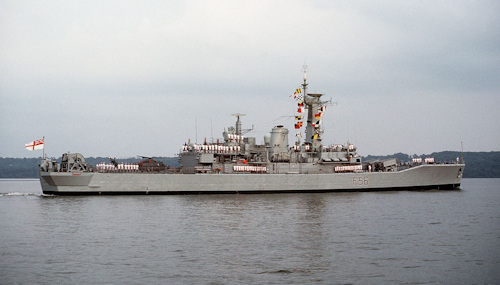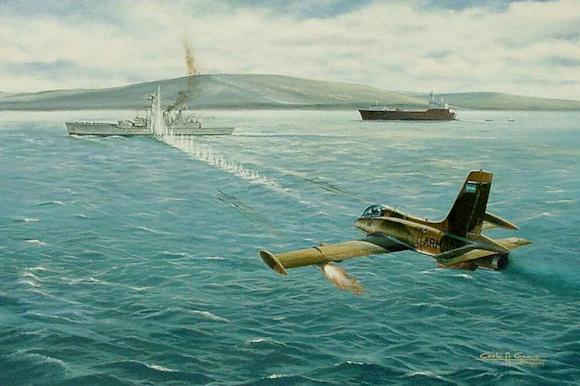The MB339, as well as its MB326 progenitor, albeit to a lesser extent, had a good sales success abroad.
Favored by good overall performance, by its wide versatility of use, and by the ability to carry a fair load of war, the then new model of Hermachim was imposed especially in all those countries that had previously adopted the MB326.
Among these countries there was also Argentina which had eight MB1968s in service since 326 with the 1st Armada Naval Air Strike Squadron on the Commander Espora base with military freshmen 3-A -... etc….
Subsequently, part of these aircraft were transferred to the Punta Indio Air Base at the Naval Air Squadron No. 4 in the 1972.
Satisfied by the previous model Aermacchi (photo), the Argentinean Navy decided, in the 1980, to acquire the MB339, in version A, for a total of ten specimens that were risked starting from 1980 always in the 1 ° Aeroonaval Attack Squadron of the Armada, framed in the 3 ° Aeronaval Squadron, with the official MC.33 designation.

The MB339, like other Argentine military airplanes, was so intensely used in the Falkland conflict by virtue of its talents and was at risk in late April of the 1982 on the Puerto Argentino Air Base (according to the English toponymy Port Stanley) along with the IA-58 Pucara and the T-34 Mentor.
These aircraft were the only ones in the Argentine arsenal, in fact, that could operate from the short track of Puerto Argentino to carry out the necessary reconnaissance missions and tactical support to the ground troops engaged in the difficult task of preventing the landing of British forces to regain the Falkland Islands .
Aware of the decisive role that these aircraft could play in the conflict that has just begun, the British Majesty's armed forces attacked the Argentine air base on the islands from the first initial stages of the conflict to eliminate permanently any war capacity.
In this regard, already on the first of May 1982 the Puerto Argentino Air Base was bombed by the British RAF using the now obsolete strategic bomber Vulcan, then in force at the squadrons n ° 44, 50 and 101, equipped for the occasion of conventional armament, with a very long raid that required multiple supplies in flight.
Despite the strong commitment, the incursion of the only one Vulcan used, "Black Buck" mission, the result was very poor: only one bomb hit the track used by Argentine airplanes, compromising only a small part of its operations.
 Other effects had the attack performed at dawn the next day by 12 Sea Harrier of the attack group ofArk Royal. Returning without losses, i Harrier Englishmen managed to destroy one Pucara and to damage three other airplanes in Buenos Aires there, also causing the killing of an Argentine pilot.
Other effects had the attack performed at dawn the next day by 12 Sea Harrier of the attack group ofArk Royal. Returning without losses, i Harrier Englishmen managed to destroy one Pucara and to damage three other airplanes in Buenos Aires there, also causing the killing of an Argentine pilot.
Thus began the turbulent life of the Argentine air detachment on the Malvinas, ever since then subjected to the threat of opposing stakes through air raids, naval cannonades, and actions of commandos, as happened in the raid on Pebble Island by the SAS against the local secondary airport where other Argentine aircraft were risky.
A turbulent life also due to the precarious operating conditions in which airplanes and pilots were found to operate because of the often bad weather conditions and the difficulty of having stable logistic connections with the continent.
Of this state of affairs he made his own expenses a MB339A the 3 May that crashed to the ground due to bad weather conditions with the death of the pilot.
The missions of the Hermit aircraft, however, never stopped. On the contrary, with the ever more evident approach of the English invasion to free the islands by sea, employing troops and landing embers, their operational use became even more intense and frenetic.
 To achieve this result, the MB339s were mainly used in reconnaissance missions and tactical support close to the Argentine troops in the area.
To achieve this result, the MB339s were mainly used in reconnaissance missions and tactical support close to the Argentine troops in the area.
One of these became justly famous thanks, above all, to the temerity shown by the Argentine pilot who put it into being. The person in question was the then Lieutenant of vessel Owen Guillermo Crippa, for irony of the sort of Italian origin.
The circumstances of this action clearly testify to the difficulties that Crippa and his Argentine colleagues had to face for the whole duration of the conflict: the night before the famous mission, when returning from a flight, the plane of his wingman was intercepted and hit by Harrier Englishmen in the area of housing the cart and had to, therefore, make an emergency landing on the runway of Puerto Argentino.
Although it was used all night to repair the aircraft, the next morning only the one piloted by Crippa was able to get up at the appointed time to perform the tasks assigned.
Assigned tasks that consisted, essentially, as previously mentioned, in making a survey of the state of the English opposing forces to catch their intentions and possibly attack the landing motorcycles that intended to bring the British invasion force to the ground, thus giving a strong hand to ground troops. To fulfill these commitments, contrary to the indications of the same pilot, the MB339A was not armed with bombs.

Rising in flight from its base, the Aermacchi flew across the sea in a northerly direction. Subsequently, the pilot decided to enter the Strait of San Carlos from the north, with the sun from behind, attached to the coast, flying to 500 feet and at a speed of just over 300 nodes.
So it was that Crippa, near the promontory of Quemes, found himself in front of a Sea Lynx helicopter of the British Task Force on a surveillance mission at a height of about 1.000 meters. While he was about to attack him, he saw in the distance what the Argentine High Command was afraid of: His Majesty's landing force escorted by several warships that had already begun operations.
Given a much more satisfying goal in the final phase of attack on the Lynx, the Argentine pilot reversed the route of attack practically touch the helicopter and launched into a desperate beaten to the English ships at full speed by making small evasive maneuvers.
The anti-aircraft fire of the Royal Navy ships was immediately very intense, especially that of the machine-gunner. Nonetheless, Crippa managed to approach the fleet and aim at one of the training escort frigates.
 Being armed only with 30 mm cannons and ZUNI rocket dispensers, the Argentine pilot, well aware that he could not aim at sinking the ship, decided to shoot at the antennas and at the control bridge of the framed frigate, which turned out to be the HMS Argonaut (picture on the right, F56 optical badge).
Being armed only with 30 mm cannons and ZUNI rocket dispensers, the Argentine pilot, well aware that he could not aim at sinking the ship, decided to shoot at the antennas and at the control bridge of the framed frigate, which turned out to be the HMS Argonaut (picture on the right, F56 optical badge).
The damage produced by the action of Crippa were all in all modest: several shots came to the 965 Type radar without destroying it. On the other hand, the escape from the English anti-aircraft fire was even more spectacular, the MB339 - military serial number 4-A-115 - and its pilot, literally passed in the middle of the enemy fleet trusting that the ships, not to hit each other , they would not have fired. And the thing actually worked by allowing Crippa to gain precious seconds and to reach the base unscathed to launch the alarm that the landing had begun and was proceeding.
Once again, however, it was demonstrated to the world the courage and skill of the Argentine pilots, able to accomplish mission from "Kamikaze" not very different from those of their Japanese colleagues about forty years before.
If with these tactics the Argentine pilots often succeeded in obtaining also resounding successes when they had available armaments suitable for the purpose - this is especially true in relation to the use of the anti-ship missiles "Exocet" - just as often, however, the missions ended tragically with the their death and the loss of the airplane.
 This also happened for the MB339A line. Specifically, the 21 May Lieutenant Corvette Daniel Miguel (photo), who piloted the MB339A matriculated 4-A-114, was shot down by a "Blowpipe" anti-aircraft missile operated by a Royal Marines while he was looking, together with a gregario , to provide close air support to the Argentine troops who defended the village of Darwin.
This also happened for the MB339A line. Specifically, the 21 May Lieutenant Corvette Daniel Miguel (photo), who piloted the MB339A matriculated 4-A-114, was shot down by a "Blowpipe" anti-aircraft missile operated by a Royal Marines while he was looking, together with a gregario , to provide close air support to the Argentine troops who defended the village of Darwin.
At this point, however, the war for the possession of the Falklands was now at an end and the British military superiority now appeared after the first difficult moments.
In early June Port Stanley fell into English hands and the 14 June was signed a ceasefire between the parties. Thus ended the war for Argentina with a heavy defeat. This will also provoke a decisive acceleration of the now dying military dictatorship that governed the fate until then.
 The new democratic system, also in order to cope with the already difficult national economic situation, decided a drastic cut in military spending. Many arrangements became so unusable due to the lack of spare parts and money needed to ensure adequate maintenance.
The new democratic system, also in order to cope with the already difficult national economic situation, decided a drastic cut in military spending. Many arrangements became so unusable due to the lack of spare parts and money needed to ensure adequate maintenance.
In order to guarantee a minimum operation of the armed forces, it was decided to discard some of the material. These included the MB339As purchased only at the beginning of the 1980s. Several specimens of the Aermacchi trainer were thus converted and used as "Gate Guardian" or museum pieces. Crippa's MB339A was even sold to a private American collector.
Paradoxically, all this did not happen for the older MB326 who continued to operate with the Naval Aviation Argentina signs up to 2007 and of which 11 were also purchased from Brazil in the MB-326GC version.
(photo: web)












